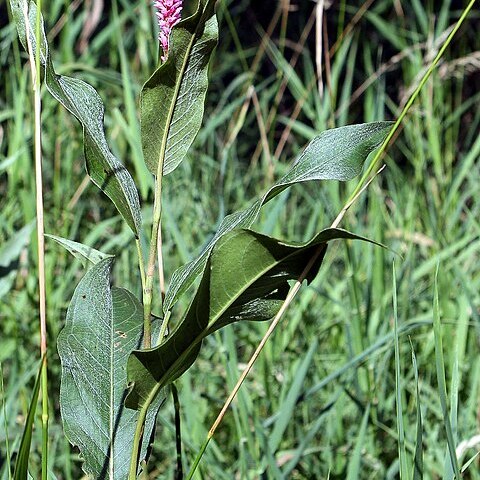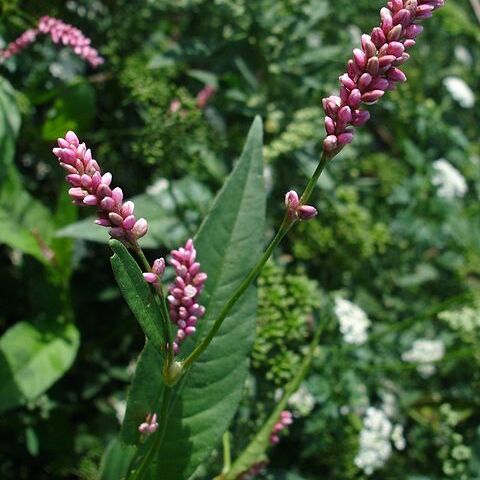Flowers perfect, occasionally with tendencies toward suppression of one sex, with pedicels distally-articulated, usually in ochreolate fascicles. Perianth of 4-5 subequal partially connate tepals, white, green, red or pink. Stamens 5-8 (-9), the filaments discrete, often unequal in length, occasionally adnate to the tepals, the anthers small, versatile, introrse, often isodiametric and appearing peltate. Ovary lenticular or trigonous; styles 2 or 3, terminated by capitate stigmata. Achene usually included, lenticular or trigonous, often beaked, the facies ovate or orbicular. Annual or perennial herbs, sometimes clambering or twining, occasionally shrubby. Leaves alternate, mostly linear to ovate, occasion-ally sagittate, cordate or hastate, the blades mostly exceeding the petioles; ochreae usually conspicuous, often fringed with strigose cilia. Inflorescences of terminal spicate panicles, racemes or cymes, in some species the flowers solitary or fasciculate in the axils; rhachises glabrous to sericeous, occasionally glandular.
Annual or perennial herbs, occasionally small shrubs, sometimes aquatic or ± scrambling; stems usually solid, with nodes usually obviously jointed and often swollen. Lvs cauline, very variable but usually considerably longer than wide, usually entire; ochreae well-developed, scarious. Infl. axillary or terminal, usually a fascicle, spiciform raceme, capitate head, or diffuse panicle; fls generally ☿, sometimes unisexual (plants monoecious or dioecious). Pedicels generally jointed. Perianth segments (4)-5-(6), persistent but usually not markedly accrescent, free or united at base, equal or nearly so, white, pink to crimson, not keeled. Stamens (3)-5-8-(9). Styles 2-3, variable in length. Fr. a biconvex or trigonous nut, enclosed or slightly exserted from the persistent, spineless perianth valves.
Hermaphrodite herbs or (rarely) shrubs, glabrous to very hairy, slender or stout, often paludal. Ocreae with or without a terminal fringe of stiff bristles. Flowers (in E. African spp.) borne in spiciform racemes or terminal capitula. Bracteoles 2, conjoined, thinly membranous and contained within the ocreiform bracts. Perianth (in E. African spp.) not accrescent, calyciform at the base, with 4–5, often imbricate, petaloid, ± persistent tepals. Stamens 5–8, included or protruding, a little dilated at the base or conjoined there into a ring. Styles 2 or 3, often united for part of their length; stigmas capitate. Ripe nuts often black and shining, acutely to obscurely trigonous, or lenticular with convex or concave (dimpled) sides.
Fls perfect or unisexual; pedicels jointed at or near the summit; tep (4)5(6), connate below; stamens 3–8; ovary flattened or trigonous, with 2–3 minute, usually capitate stigmas, the styles usually short or obsolete, separate or united; fr a lenticular or trigonous achene, wholly or in large part enclosed by the persistent perianth; embryo at one angle of the achene; annual or perennial herbs (seldom shrubs), commonly with well developed ocreae; fls borne in axillary clusters or terminal (often also axillary) spike-like racemes, or in terminal heads or panicles. Most of the several sections have been taken by some authors as distinct genera. Our spp. mostly flower from early or midsummer into fall. 200, widespread, mainly temp.
Herbs, rarely subshrubs, or small shrubs, rarely dioecious. Stems erect, prostrate, or ascending, usually with conspicuously swollen nodes, glabrous or pubescent, rarely prickly. Leaves simple, alternate, subsessile; leaf blade variously shaped, margin entire; ocrea tubular, membranous, margin entire or lacerate, apex truncate or oblique. Inflorescence terminal or axillary, racemose, spicate, capitate, or paniculate, sometimes flowers fascicled or solitary in axils of leaves. Pedicel often articulate. Flowers bisexual, rarely unisexual; bracts and bracteoles membranous. Perianth persistent, 5(or 4)-parted. Stamens 7 or 8, rarely 4. Styles 2 or 3, deciduous, mostly elongate. Achenes trigonous or biconvex, rarely biconcave.
Perianth segments (4)5, equal or somewhat unequal in length, spirally arranged, often imbricate, free or united in the lower part, petaloid at least in part, with only one main vein (the vein sometimes branched); outer segments keeled or slightly angular, different from the inner.
Stamens 4–6, rarely fewer, included or not; filaments broadly dilated in the lower half, free or sometimes united at the base into a ring; anthers globose or ellipsoid, dorsifixed; interstaminal nectaries lacking.
Flowers hermaphrodite, rarely unisexual, solitary or in sessile fascicles springing from the axils of bracts; bracteoles 2, fused, thinly membranous and contained within the bracts.
Leaves alternate, small, usually less than 2 cm long and articulated at the base, lanceolate-elliptic to oblong.
Nut trigonous, enclosed in the persistent perianth or protruding from it for less than half its length.
Annual or perennial prostrate or semi-erect herbs (rarely shrubs), glabrous or hairy.
Ocrea membranaceous, silvery or white, often deeply lacerate, glabrous.
Ovary included in the perianth; styles (2)3, free; stigmas capitate.
Stems much branched.


